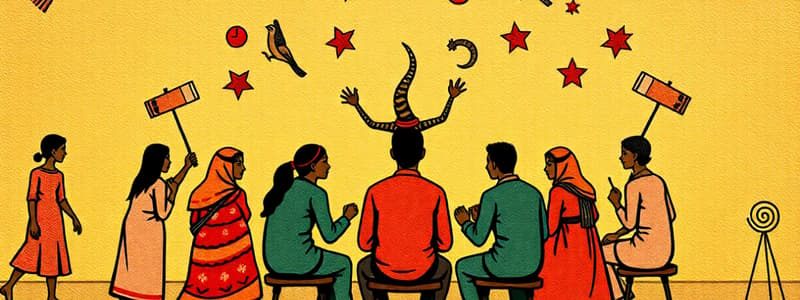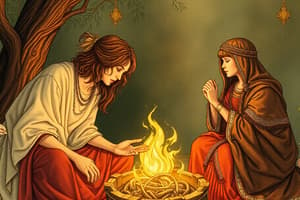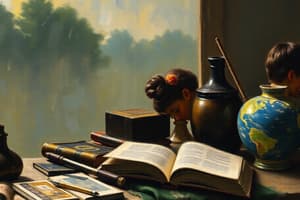Podcast
Questions and Answers
What was observed lying on the ground around the scene described?
What was observed lying on the ground around the scene described?
- Office chairs, computer parts, and bricks (correct)
- Furniture and household appliances
- Discarded food items and clothing
- Personal belongings of the campers
What type of structure did the narrator's father’s sleeping area resemble?
What type of structure did the narrator's father’s sleeping area resemble?
- A traditional house with four walls
- An underground shelter with no windows
- A makeshift space resembling a cave (correct)
- A modern apartment with contemporary furnishings
What item was specifically identified as belonging to the narrator's mother?
What item was specifically identified as belonging to the narrator's mother?
- A framed plastic ID card (correct)
- A set of wool blankets
- Her personal rosary beads
- A cot for sleeping
What were the campers doing while following the Council's man?
What were the campers doing while following the Council's man?
What characterized the construction of the father’s sleeping area?
What characterized the construction of the father’s sleeping area?
What emotion did the narrator most prominently express when encountering the water?
What emotion did the narrator most prominently express when encountering the water?
How does the brook's movement in the narrative primarily get described?
How does the brook's movement in the narrative primarily get described?
What physical action does the narrator take when they first see the brook?
What physical action does the narrator take when they first see the brook?
What relationship dynamic is illustrated between the narrator and the girl?
What relationship dynamic is illustrated between the narrator and the girl?
What does the narrator's memory of their uncle primarily evoke?
What does the narrator's memory of their uncle primarily evoke?
What do the 'tenacious roots' symbolize in the context of the water description?
What do the 'tenacious roots' symbolize in the context of the water description?
Why were the narrator and Mitch sent to the uncle’s cabin?
Why were the narrator and Mitch sent to the uncle’s cabin?
Which of the following best describes the narrator's feelings towards their parents as indicated in the passage?
Which of the following best describes the narrator's feelings towards their parents as indicated in the passage?
What was the significance of the thinning group in the journey?
What was the significance of the thinning group in the journey?
What was Miig's role in the group?
What was Miig's role in the group?
What did the marks on the elm tree represent?
What did the marks on the elm tree represent?
What emotion did the protagonist experience due to decision-making in the journey?
What emotion did the protagonist experience due to decision-making in the journey?
What practical step did the group take the day after finding the tree markings?
What practical step did the group take the day after finding the tree markings?
What feeling did Miig express when discovering the markings on the tree?
What feeling did Miig express when discovering the markings on the tree?
How did the group’s size impact their movement strategy?
How did the group’s size impact their movement strategy?
What internal struggle did the protagonist face at night?
What internal struggle did the protagonist face at night?
What is the initial reaction of Wab when asked to help pack up camp?
What is the initial reaction of Wab when asked to help pack up camp?
How does the man with the long hair initially treat the group?
How does the man with the long hair initially treat the group?
What is the protagonist's interaction with the man who disarmed them?
What is the protagonist's interaction with the man who disarmed them?
What is Miig's relationship to the protagonist as indicated in the content?
What is Miig's relationship to the protagonist as indicated in the content?
What does the protagonist think about the man's attitude?
What does the protagonist think about the man's attitude?
What does the protagonist decide to do while packing?
What does the protagonist decide to do while packing?
What is indicated about the relationship between the protagonist and Rose?
What is indicated about the relationship between the protagonist and Rose?
What description is given about the old man in the camp?
What description is given about the old man in the camp?
What can be inferred about the character Miig's past experiences?
What can be inferred about the character Miig's past experiences?
What does the female guard imply when she states, 'we don’t need help from anyone'?
What does the female guard imply when she states, 'we don’t need help from anyone'?
Which facial expression is portrayed by the narrator when addressing the guards?
Which facial expression is portrayed by the narrator when addressing the guards?
What role does the character Rose play during this encounter?
What role does the character Rose play during this encounter?
What does the narrator suggest with the statement about their clothing and weapons?
What does the narrator suggest with the statement about their clothing and weapons?
What does the characterization of the older man who follows the female guard signify?
What does the characterization of the older man who follows the female guard signify?
What does the presence of crossbows among the guards convey?
What does the presence of crossbows among the guards convey?
What theme is highlighted by the interactions between the narrator and the guards?
What theme is highlighted by the interactions between the narrator and the guards?
Flashcards are hidden until you start studying
Study Notes
The Journey
- The group is travelling to find the resistance near Espanola
- The group is made up of Miigwans, Chi-Boy, Rose and a nameless narrator
- The narrator feels responsible for the group's current situation because his actions led them to this point
- The narrator struggles with the burden of potentially leading the group towards danger
Discovering Signs
- The group comes across syllabics carved on a tree
- The narrator recognizes the syllabics from Minerva's nightly check-ins
- Miigwans explains that the carvings mean there are Nish people nearby
- Miigwans is hopeful about the impending meeting despite past experiences with the Nish
The Importance of Water
- Rose discovers a brook of fresh water
- The discovery of the brook is described as a moment of joy and relief
- The brook symbolizes a small source of life and hope in a harsh world
Meeting the Intruders
- The group encounters a group of armed individuals
- The individuals are later revealed to be Nish
- The narrator suspects that the individuals are the ones who left the syllabic carvings
- The group claims to have been looking for help
The Importance of Belonging
- The narrator and his group are taken prisoner
- One of the captors states that no one helps anyone anymore and that no one needs help
- The narrator argues with the captors about their intentions and their appearance
- The narrator uses his experience with snitches to intimidate the captors
- The narrator physically comforts Rose, who shivers due to the cold morning
The Arrival of the Nish Leader
- The Nish leader arrives and demands that the group be treated as guests
- The Nish leader recognizes Miigwans
- One of the guards offers to help the narrator set up camp and retrieve his gun
- The narrator rejects the guard's advances.
The Nish Leader’s Identity
- The narrator is unable to place the Nish leader's identity
- Miigwans recognizes the leader and mentions losing an elder
- The scene shifts to a previous incident involving the council's man.
- The council's man observes the campers praying over the ashes and smoke of a destroyed settlement.
The Significance of the Health Card
- The narrator finds his mother’s health card in his father's belongings
- It offers a glimpse into the narrator’s past and his family's history
- The narrator uses the health card as a symbolic representation of his lost life and loved ones.
Studying That Suits You
Use AI to generate personalized quizzes and flashcards to suit your learning preferences.




